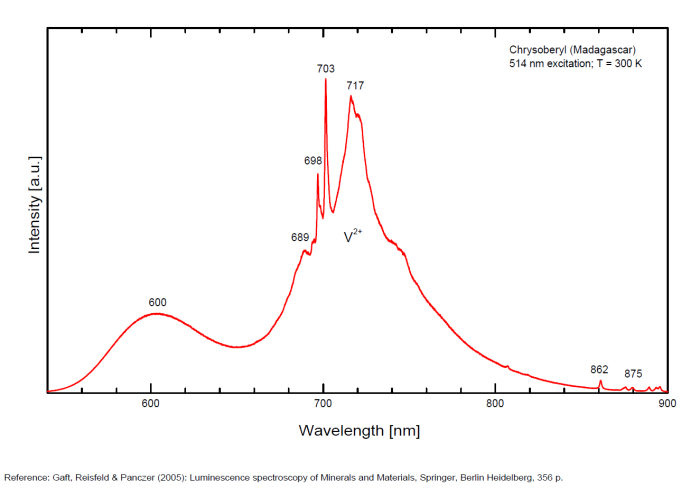Database of luminescent minerals
CHRYSOBERYL
Chemical formula: BeAl2O4
Family: Oxides and hydroxides
Status: IMA-GP
Crystal system : Orthorhombic
Display mineral: NON
Associated names (luminescent varieties, discredited names, synonyms, etc.): alexandrite,
Luminescence:
Longwave UV (365nm) colors: |
Red , | ||
Intensity LW:Very weak | |||
Midwave UV (320nm) colors: |
Red , | ||
Shortwave UV (254nm) colors: |
Red , Greenish Yellow , | ||
Intensity SW:Very weak | |||
Do you have a photo of this mineral you would like to see in the gallery? Contact us!
Phosphorescence (in the common sense of the term) observable with the naked eye:
No phosphorescence visible to the naked eye under any type of UV
Comments:
Varété alexandrite: fluorescence rouge due au chrome (Cr2+)
Chrysobéryl classique: jaune vert, crème, verdâtre;
Activator(s) and spectrum:
Activator(s): Cr3+, V2+,
Peaks in the spectrum (nm):
Cr3+ replacing Al : 678, 680 nm V2+ : band around 720 nm (80nm half-width) (Gaft), VO6 : broad band at 645nm (FWHM: 120nm) TiO6 : 516nm (FWHM: 115nm) (Gaft), band at 540 nm (Gorobets), 689, 698, 703nm (Gaft)

Spectrum: Michael Gaft, Petah Tikva, Israel. Plot: Institute of Mineralogy, University of Vienna, Austria, with permission of the authors.
Comments on spectrum and activators:
The Al3+ ions are octahedrally coordinated by the oxygen ions and occur in two not equivalent crystal field sites in the lattice. The Cr3+ ions replace substitutionally the Al3+ ions, 78 % replacing Al3+ ions in one position and the rest going into the second sites. The major features of the spectra at 300 K are the two sharp lines R1m (m for mirror, the first position for Al3+ replacement) and R2m peaking at 680 nm and a broad, structured band peaking at lower energies. The 689.5 and 695.2 nm decay time is much larger than that for the 677.9 and 679.5 nm emission (Suchoki et al. 1987). At certain excitation wavelengths, such as 488nm, the R1i (i for inversion) and R2i peaking at 690.0 and 695.0 nm lines associated with Cri ions in inversion sites (second site) appear (Powell et al. 1985) The Cr3+ luminescence properties in natural chrysoberyl minerals have been studied as a function of the Cr content as well as impurities such as Fe and V. A competition was found between Cr and V for very low Cr concentration with the vanishing of Cr3+ emission from Cr3+ ions located in inversion site. The Fe3+ ions substitute in mirror site efficiently with a strong impact on the Cr3+ lifetime of mirror site (Ollier et al. 2015). Cathodoluminescence: red;
Best localities for fluorescence (*):
- Takovaja River, Ural Mountains, Russia (var. Alexandrite fluo red);
- Izumrudnye Kopi area, Malyshevo, Sverdlovsk Oblast, Ural, Russia;
- Santa Teresa, Espirito Santo, Brazil (yellow SW);
- Haddam, Connecticut, USA (SW yellow green);
(*)The data are not exhaustive and are limited to a few remarkable localities for fluorescence
Bibliographic reference for luminescence:
- The Henkel Glossary of Fluorescent Minerals, Dr. Gerhard Henkel, Published by the FMS, 1989 ,
- Fluorescence: Gems and Minerals Under Ultraviolet Light, Manuel Robbins, 1994, Geoscience Press, ISBN 0-945005-13-X ,
- Luminescence Spectroscopy of Minerals and Materials, M. Gaft, R. Reisfeld, G. Panczer, Springer Editor, ISBN: 10 3-540-21918-8 ,
- Luminescent Spectra of Minerals, Boris S. Gorobets and Alexandre A. Rogojine, Moscow, 2002 ,
- Handbook of Fluorescent Gems and Minerals, a practical guide for the gem and mineral collector, Jack de Ment, 1949 ,
Mineralogical reference on the Internet:
 http://www.mindat.org/show.php?name=Chrysoberyl
http://www.mindat.org/show.php?name=Chrysoberyl
 http://webmineral.com/data/Chrysoberyl.shtml
http://webmineral.com/data/Chrysoberyl.shtml
Internet Search:
 Image search on 'Google Images'
Image search on 'Google Images'
 Search for documents in all languages on Google
Search for documents in all languages on Google
A request providing no result means only that no such reference exists in the database, but it does not mean that what you are looking for does not exist, just not to our knowledge. If you think you have found an error or omission, please let us know via the contact page being sure to cite the source of information.
